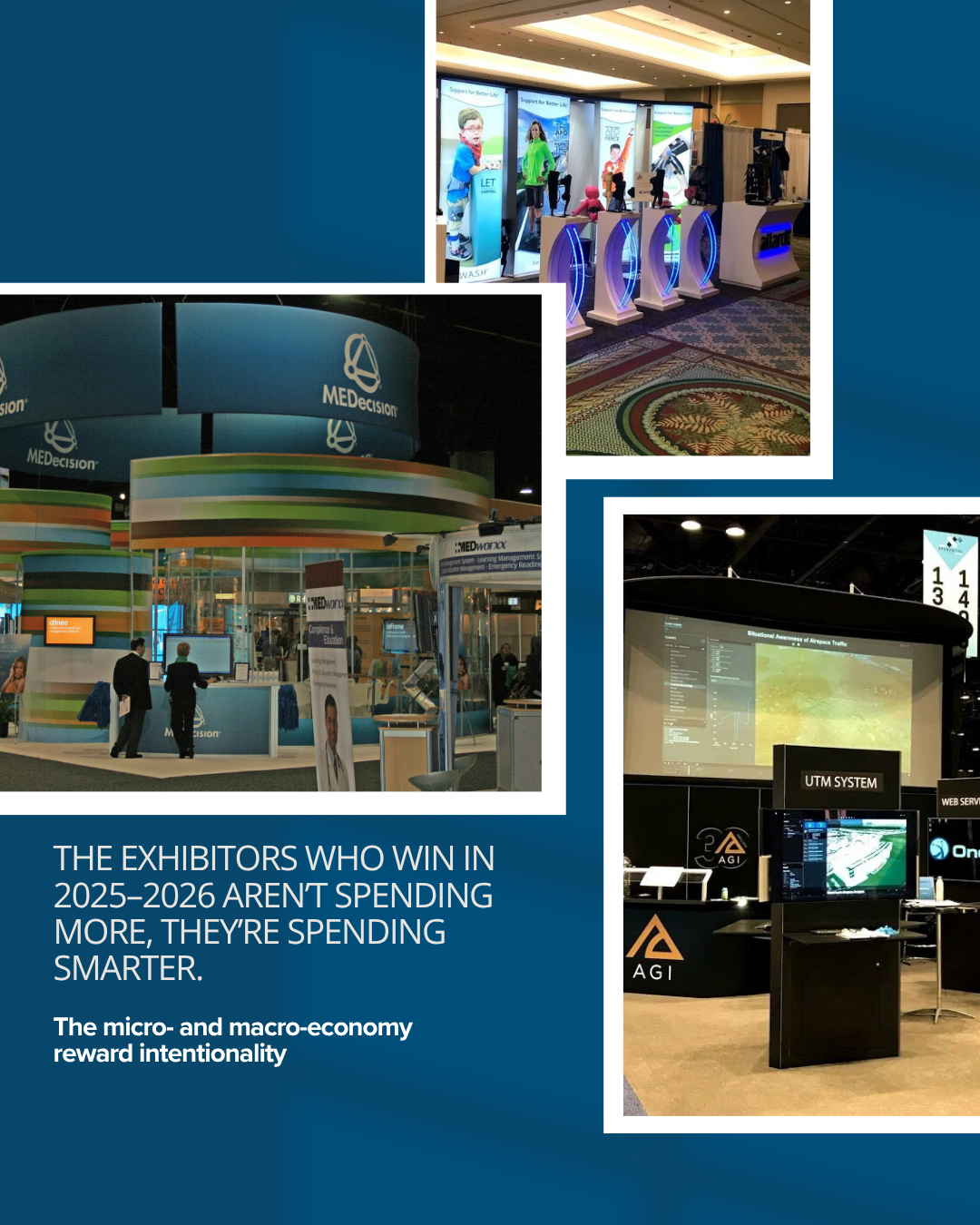Navigating Micro and Macro Economic Shifts in the Trade Show Industry: A Practical Guide for Exhibitors in 2025–2026
The trade show landscape is changing faster than ever. Between rising costs, shifting attendee behavior, supply-chain volatility, and corporate budget pressure, exhibitors are operating in a world where both microeconomic factors (the internal economics of exhibiting) and macroeconomic conditions (the broader economy) directly shape strategy, design, and ROI.
Success in 2025–2026 isn’t about spending more; it’s about being smarter, more intentional, and more strategic with every dollar, every decision, and every booth experience.
At Steel City Displays, we refer to this as Radical Intentionality. And right now, exhibitors who adopt this mindset are the ones staying resilient, maximizing ROI, and creating meaningful brand impact despite economic uncertainty.
Below is a practical, exhibitor-focused guide to managing the micro and macro economy shifts influencing the trade show industry today.
Understanding the Economic Forces That Shape Trade Show Performance
The Macroeconomy: Big Forces That Influence Exhibiting
Macroeconomic conditions, inflation, interest rates, corporate spending, supply-chain constraints, and travel costs influence:
Whether companies increase or reduce trade show budgets
How many shows they attend
How large their booth footprint is
How early (or late) decisions are made
Whether new builds are approved or deferred
When the macroeconomy tightens, exhibitors naturally become more selective, more ROI-driven, and more cautious with logistics and materials.
When it strengthens, they expand, reinvest, and innovate.
The Microeconomy: The “Unit Economics” of Your Exhibit Program
The micro-economy of exhibiting is the small-scale system exhibitors operate within the decisions you control:
Cost per lead
Cost per conversation
Conversion quality
Staffing levels
Drayage and shipping
Materials and fabrication
Reuse vs. new build
Show selection and audience alignment
Understanding your own microeconomics helps determine where you get the highest return on your investment and where waste can be eliminated.
The key is managing both forces together, because the macro conditions set the stage, but your micro-level decisions determine your results.
How Exhibitors Can Respond to Macro-Economic Shifts
1. Be Strategic with Show Selection
Not every show deserves a place in your portfolio.
Use macro trends to refine your calendar:
Rising travel and hotel prices? Lean into regional events.
Industry downturn? Prioritize intent-driven shows.
Budget tightening? Reduce footprint, not presence.
Small, strategic changes create major downstream savings.
2. Build Multi-Year Value into Your Exhibit Assets
Inflation and supply-chain challenges make single-use booths increasingly impractical.
Optimize your long-term costs by:
Investing in modular, scalable exhibit systems
Designing elements that reconfigure across multiple shows
Choosing lightweight materials to reduce drayage
Planning storage and refurb options up front
Multi-year planning flattens macroeconomic cost spikes.
3. Strengthen Pre-Show and Post-Show Strategy
When marketing budgets tighten, exhibitors must squeeze value out of every phase:
Pre-show: targeted digital ads, warm outreach, attendee mapping
During: purposeful booth flows, trained staff, engagement tech
After: automated follow-up, content recaps, sales collaboration
This not only protects your investment — it multiplies it.
4. Lock In Logistics Early
Fuel costs, labor shortages, shipping delays, and rising materials are macro issues outside your control.
You can control:
earlier shipping deadlines
earlier approvals
earlier ordering of graphics, AV, and rentals
multi-show planning to lock in pricing
Early planning reduces risk, cost, and stress.
How Exhibitors Can Respond to Micro-Economic Shifts
1. Track Costs and Performance at the Unit Level
What is your cost per qualified conversation?
Which engagement strategies produce the highest ROI?
Which show generates the right buyers, not just foot traffic?
This data turns your trade show program into a revenue engine rather than a cost center.
2. Lean Into Purposeful Design
Every inch of your booth, every visual, every lighting choice, every demo should ladder up to:
your story
your goals
your audience
Purpose-driven design improves the micro-economy of your exhibit by eliminating distractions and maximizing high-value interactions.
3. Don’t Overstaff — or Understaff
Staffing is one of the most overlooked micro-economy levers.
Train your team not just to “work the booth” but to:
listen
qualify
guide meaningful conversations
move prospects into clear next steps
Effective staffing increases ROI and reduces the cost per lead by 20–40%.
4. Reuse, Refresh, and Repurpose
You don’t need a new booth to create a new experience.
Often:
new graphics
updated lighting
refreshed flooring
an added demo station
an updated product display
…can give your booth new energy while protecting your micro-economics.
Where Micro and Macro Meet: The Exhibitor Sweet Spot
True trade show resilience happens at the center of both economic forces.
When you respond to macro conditions with thoughtful micro decisions, you build a trade show program that is:
more resilient
more predictable
more efficient
more profitable
more aligned with your long-term goals
This is where exhibitors create unfair advantage through clarity, intentionality, and strategy.
The Power of WE: How Steel City Displays Supports Exhibitors Through Economic Shifts
At Steel City Displays, we’ve helped exhibitors navigate fluctuating economic conditions for decades. Through expert fabrication and strategic partnership, we help you:
optimize your trade show program for any economic climate
design with purpose and measurable ROI
build modular, flexible assets that last
plan for logistics and costs long before deadlines
create experiences that connect, convert, and deliver a long-term pipeline
No matter what the macroeconomy is doing, you don’t have to navigate it alone.
That’s the Power of WE.
Ready to strengthen your trade show strategy for 2025–2026?
Our team of experts has more than 100+ combined years of exhibit, fabrication, and experiential marketing experience and we’re here to help you navigate every economic shift with clarity and confidence.
Let’s build your next high-impact, ROI-driven exhibit together. Contact Steel City Displays

